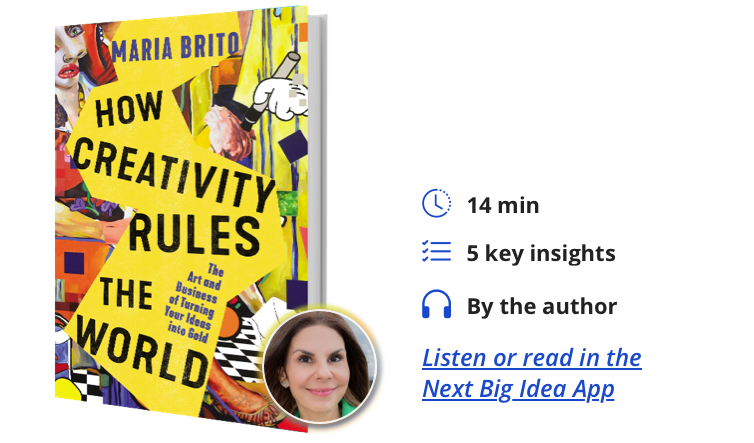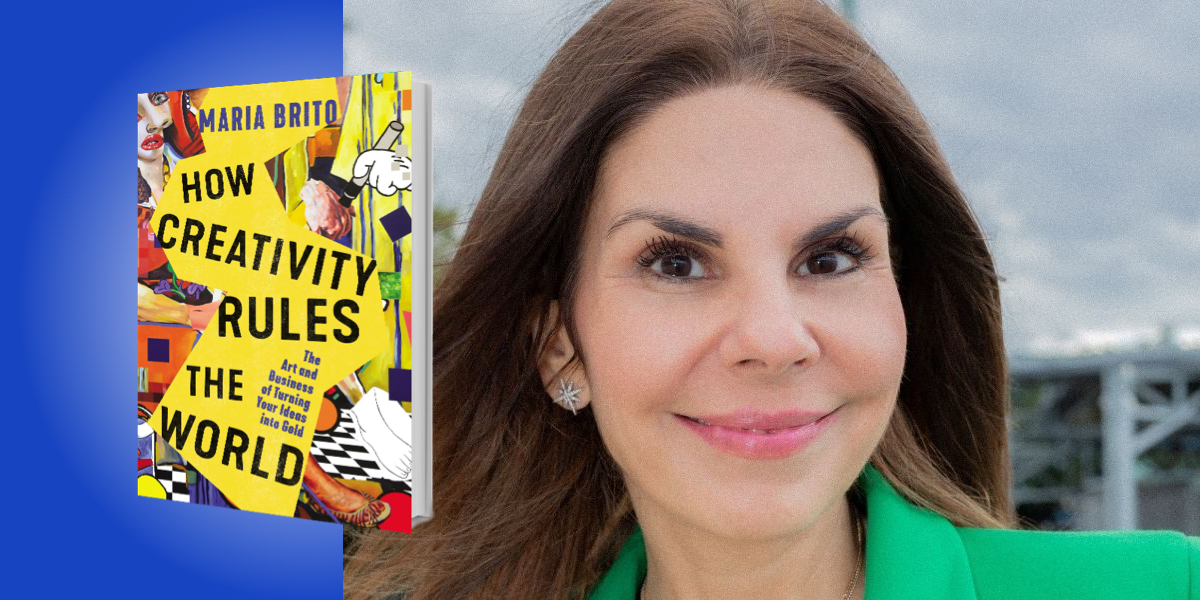Maria Brito is an award-winning contemporary art advisor and curator. She has written for publications such as the Huffington Post, Elle, and Forbes, and her projects have been featured in the New York Times, the Wall Street Journal, and Vogue, among others.
Below, Maria shares 5 key insights from her new book, How Creativity Rules the World: The Art and Business of Turning Your Ideas into Gold. Listen to the audio version—read by Maria herself—in the Next Big Idea App.

1. Creativity is your most precious skill to develop.
Every breakthrough, in every industry, comes from people who used their creativity to think differently. Developing your unique ability to express your ideas while generating value for the clients, audience, or people you serve will take you far.
Whether you are an entrepreneur, artist, or employee, your creativity helps turn the mundane into the extraordinary. This is the most crucial skill to have on your path toward success. Creative people come up with solutions that are relevant and novel for today’s world.
For many years, LinkedIn has been scanning the information shared by roughly 800 million professionals, searching for the skills that were most in-demand in relation to its supply. The number one in-demand skill turns out to be creativity. During the pandemic, the World Economic Forum called creativity “the one skill that will future-proof you for the job market.” Interestingly, Adobe also interviewed 5,000 adults in the United States, United Kingdom, Germany, France, and Japan, which showed that only one in four people believed they were living up to their creative potential, and four in ten said that they didn’t have the tools or access to the tools they needed to become creative.
This creativity gap between what industries, companies, and societies are clamoring for and what people believe they can contribute is plain wrong. Everyone is and can be creative, and the tools aren’t hard to find or expensive. In fact, they already belong to each one of us.
2. Creativity is innate.
In 1968, an Arizona scientist, Dr. George Land, along with his partner and wife, Dr. Beth Jarman, conducted a research study to test the creativity of 1,600 children, ranging from three to five years old, who were enrolled in a Head Start program. They developed the original creativity test at the request of NASA, who wanted to select the most innovative engineers and scientists, and assign them to their most difficult problems.
“The way back to our five-year-old selves is by respecting and nurturing our fertile imaginations, the ideas that seem silly and outlandish, and allowing them to come to the surface and become concrete creations.”
The test consisted of looking at a problem and coming up with new, different, innovative ideas. 98 percent of the five-year-olds scored at the highest level of creativity. Land and Jarman retested the same children at age ten, and again at age fifteen. The results were quite different; only 30 percent of the ten-year-olds and merely 12 percent of the fifteen-year-olds scored at the highest level of creativity. When they gave the same test to 280,000 adults whose average age was 30, only two percent scored as highly creative.
The findings of these studies were, and continue to be, astounding. According to Land, the issue stemmed from educational systems that push children toward what to think rather than how to think. Land proved that creativity is a normal part of every human being, and that it is suppressed as we learn more rules, facts, and “unquestionable” theories, as well as by standardized tests that insist on only one correct answer for each question. Based on Land’s conclusions, the way back to our five-year-old selves is by respecting and nurturing our fertile imaginations, the ideas that seem silly and outlandish, and allowing them to come to the surface and become concrete creations.
3. Creativity is for everyone.
There’s a myth that perpetuates the idea that creativity is only for artists, or that it only belongs to geniuses who come to this Earth once in a blue moon. That hurts us as a society because it places creativity in the hands of just a handful of people. Everyone is capable of coming up with excellent ideas that can be materialized to positively serve a group of people.
Creativity is the use of known or old information and ideas to produce something relevant and new. It is your unique ability to come up with ideas of value, and it applies to all industries. Creativity is also not one single thing; it is an amalgamation of habits and mindsets nurtured by will and design. Creativity is what allows artists and entrepreneurs to move, shake, invent, disrupt, and transition as often as needed to meet challenges in our convoluted world, where change is the only constant.
People tend to think that the creative process is different for artists and for businesspeople, but science has proven that the creative process for people in areas as far apart as math, engineering, and the arts is the same. After examining 2,277 university students in Germany, researchers from Maastricht University and the University of South Australia concluded that creative thinking doesn’t differ much across domains and disciplines. While it is true that CEOs, programmers, and artists create different kinds of work with diverse intentions and outcomes, the skills and attitudes they use to get there are very similar.
“While it is true that CEOs, programmers, and artists create different kinds of work with diverse intentions and outcomes, the skills and attitudes they use to get there are very similar.”
I once was a miserable corporate attorney working at a big law firm in New York City, confined by restrictive rules and surroundings. After much soul-searching, I left that well-paid and stable job to start my own business in a completely unrelated industry, with no connections, no clients, no previous training, and no formal education in the business of art. Had I not learned how to develop my own creativity, I wouldn’t have made it this far. It’s been thirteen years of tremendous joy, entrepreneurial effort, and hard work, but mostly my ability to generate thousands of ideas and relentlessly pursue and execute the most original ones.
4. Creativity is fueled by crisis.
Creativity and crisis are related. The biggest human developments, major industrial advances, greatest inventions, and most important art movements have happened after big crises. The Italian Renaissance followed on the heels of the Black Death in the late 1300s. The Bauhaus, modernism, surrealism, and art deco movements came in the 1920s after the Spanish flu ravaged the world and the devastation of World War I was felt in every corner of the planet.
We wouldn’t have Picasso’s Guernica, painted in 1937, had it not been for the Spanish Civil War. The Great Depression brought Franklin Delano Roosevelt’s “New Deal” between 1933 and 1939, and with it the creation of several agencies that engaged artists in public art projects all over the United States. The era of “content creators,” the propagation of digital images and videos, leveraged by the social media revolution, came after the economic collapse of 2008. When we find ourselves with limited resources, confront harsh conditions, or need to figure out how to react to difficulty, creativity thrives.
In 1959, in the middle of the Cold War, the United States started to get serious about the ideas of “creativity” and “free thinking” to differentiate itself from the totalitarianism of the Soviet Union. Between the 1950s and the 1960s, the Central Intelligence Agency used abstract expressionism as a weapon in the Cold War. By financing abstract expressionism, the United States would show the world that this new movement was the quintessential expression of creativity, intellectual freedom, and cultural power. Russian art, stifled and communist, didn’t stand a chance next to the exuberance, energy, and dynamism of its American counterpart.
“This is a common sentiment among history’s greatest thinkers and creators: creativity takes work, but mostly, it takes action.”
Science even proved the connection between creativity and crisis. Marie Forgeard, an American psychologist, conducted the first empirical study (of 373 participants) proving that there are increased levels of creativity in people who have faced crises and adversity. Forgeard calls these spikes in creativity resulting from severe challenges “post-traumatic growth.” That doesn’t mean adversity is needed for creativity—ou don’t have to suffer to become creative. But if you find yourself in the middle of a crisis, know that it can be a catalyst for progress and originality.
5. Creativity requires action.
You must put in the time to understand that creativity is a series of actions that bring about desired results. The operative word is “action”—creativity eludes those who sit down and wait for it to come. Your ability to respond swiftly to changes and come up with novel, realistic ideas will determine your long-term survival and success in any endeavor. And I believe that everyone is an alchemist who can turn ideas into gold.
We can look at Picasso’s life and learn from him. It is no coincidence that he still holds first place, certified by Guinness World Records, as history’s most prolific visual artist: 13,500 paintings and designs; 100,000 prints and engravings; 34,000 book illustrations; and 300 sculptures and ceramics. What was his secret? He worked every day, obsessively, and pursued the solitary aim of his art to the exclusion of practically everything else.
Picasso’s friend Brassaï asked him, “Where do you get so many ideas?” Picasso answered, “Ideas are simply starting points . . . As soon as I start to work, others well up in my pen. To know what you’re going to draw, you have to begin drawing.” Picasso, one of the greatest geniuses of history, painted one and sometimes two canvases a day, and told his friend, in his own words, that creativity is a “do.” This is a common sentiment among history’s greatest thinkers and creators: creativity takes work, but mostly, it takes action.
To listen to the audio version read by author Maria Brito, download the Next Big Idea App today:





























